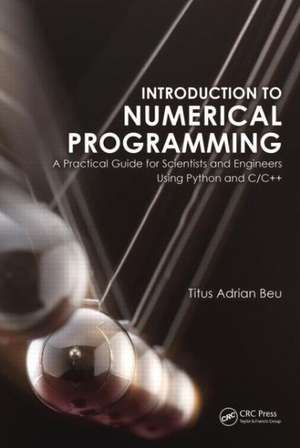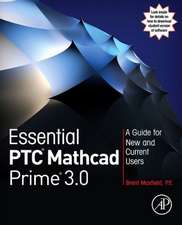Introduction to Numerical Programming: A Practical Guide for Scientists and Engineers Using Python and C/C++: Series in Computational Physics
Autor Titus A. Beuen Limba Engleză Paperback – 3 sep 2014
Bearing in mind the evolution of modern programming, most specifically emergent programming languages that reflect modern practice, Numerical Programming: A Practical Guide for Scientists and Engineers Using Python and C/C++ utilizes the author’s many years of practical research and teaching experience to offer a systematic approach to relevant programming concepts. Adopting a practical, broad appeal, this user-friendly book offers guidance to anyone interested in using numerical programming to solve science and engineering problems. Emphasizing methods generally used in physics and engineering—from elementary methods to complex algorithms—it gradually incorporates algorithmic elements with increasing complexity.
Develop a Combination of Theoretical Knowledge, Efficient Analysis Skills, and Code Design Know-How
The book encourages algorithmic thinking, which is essential to numerical analysis. Establishing the fundamental numerical methods, application numerical behavior and graphical output needed to foster algorithmic reasoning, coding dexterity, and a scientific programming style, it enables readers to successfully navigate relevant algorithms, understand coding design, and develop efficient programming skills. The book incorporates real code, and includes examples and problem sets to assist in hands-on learning.
- Begins with an overview on approximate numbers and programming in Python and C/C++, followed by discussion of basic sorting and indexing methods, as well as portable graphic functionality
- Contains methods for function evaluation, solving algebraic and transcendental equations, systems of linear algebraic equations, ordinary differential equations, and eigenvalue problems
- Addresses approximation of tabulated functions, regression, integration of one- and multi-dimensional functions by classical and Gaussian quadratures, Monte Carlo integration techniques, generation of random variables, discretization methods for ordinary and partial differential equations, and stability analysis
Preț: 757.54 lei
Preț vechi: 946.93 lei
-20% Nou
Puncte Express: 1136
Preț estimativ în valută:
144.97€ • 150.80$ • 119.68£
144.97€ • 150.80$ • 119.68£
Carte tipărită la comandă
Livrare economică 14-28 aprilie
Preluare comenzi: 021 569.72.76
Specificații
ISBN-13: 9781466569676
ISBN-10: 1466569670
Pagini: 674
Ilustrații: 124 black & white illustrations, 8 black & white tables
Dimensiuni: 178 x 254 x 41 mm
Greutate: 1.15 kg
Ediția:1
Editura: CRC Press
Colecția CRC Press
Seria Series in Computational Physics
Locul publicării:Boca Raton, United States
ISBN-10: 1466569670
Pagini: 674
Ilustrații: 124 black & white illustrations, 8 black & white tables
Dimensiuni: 178 x 254 x 41 mm
Greutate: 1.15 kg
Ediția:1
Editura: CRC Press
Colecția CRC Press
Seria Series in Computational Physics
Locul publicării:Boca Raton, United States
Recenzii
"This book is written for advanced undergraduate and graduate students in natural sciences and engineering for a one- or two-semester course. The material presented includes many topics treated in a numerical analysis course and contains a lot of coding examples in Phyton, and C/C++. ... The value of the book lies in the presentation of the programming and a program example on almost every second page."
—Gudula Rünger, Zentralblatt MATH, 1308
"In a relatively crowded field of numerical programming books, this is the only one to include both Python and C code examples. … a good reference for a one- or two-semester course for advanced undergraduate students or for graduate students in science or engineering."
—Optics & Photonics News, 2015
"Working through this book you will become an expert in numerical techniques … . Your journey will be a real pleasure since the book focuses on thorough explanations, hands-on code examples, and graphical representations."
—Professor Dr. Alexander K. Hartmann, Institute for Physics, University of Oldenburg
"… by taking simple mathematical examples and translating them into what the computer actually does, this textbook provides us with a good picture of what is achieved in a numerical simulation. A basic necessity for whoever wants to address more complex coding and algorithms!"
—Professor Michel Mareschal, Department of Physics, Université Libre de Bruxelles
"This is a useful book, both as a text and as a reference for computational physics students and instructors. Right from the first chapter about errors it provides an invaluable resource for aspects that are often not sufficiently emphasised, despite their importance for reliable calculations. I strongly recommend it for everyone's bookshelf."
—Professor Joan Adler, Technion, Israel Institute of Technology
"… a comprehensive introduction to classical numerical methods for advanced-level undergraduate students in the physical sciences, engineering, and applied mathematics. The book is novel in teaching both numerics and the art of programming, via clear and simple codes in Python and C/++. … I will recommend it to my students."
—Professor Mike Wheatland, The University of Sydney
"This book is unique in providing an introduction to [numerical methods, programming languages, and graphics]. Each topic is clearly explained and can be practiced using ready-made computer programs."
—Professor R.I. Campeanu, York University, Toronto
—Gudula Rünger, Zentralblatt MATH, 1308
"In a relatively crowded field of numerical programming books, this is the only one to include both Python and C code examples. … a good reference for a one- or two-semester course for advanced undergraduate students or for graduate students in science or engineering."
—Optics & Photonics News, 2015
"Working through this book you will become an expert in numerical techniques … . Your journey will be a real pleasure since the book focuses on thorough explanations, hands-on code examples, and graphical representations."
—Professor Dr. Alexander K. Hartmann, Institute for Physics, University of Oldenburg
"… by taking simple mathematical examples and translating them into what the computer actually does, this textbook provides us with a good picture of what is achieved in a numerical simulation. A basic necessity for whoever wants to address more complex coding and algorithms!"
—Professor Michel Mareschal, Department of Physics, Université Libre de Bruxelles
"This is a useful book, both as a text and as a reference for computational physics students and instructors. Right from the first chapter about errors it provides an invaluable resource for aspects that are often not sufficiently emphasised, despite their importance for reliable calculations. I strongly recommend it for everyone's bookshelf."
—Professor Joan Adler, Technion, Israel Institute of Technology
"… a comprehensive introduction to classical numerical methods for advanced-level undergraduate students in the physical sciences, engineering, and applied mathematics. The book is novel in teaching both numerics and the art of programming, via clear and simple codes in Python and C/++. … I will recommend it to my students."
—Professor Mike Wheatland, The University of Sydney
"This book is unique in providing an introduction to [numerical methods, programming languages, and graphics]. Each topic is clearly explained and can be practiced using ready-made computer programs."
—Professor R.I. Campeanu, York University, Toronto
Cuprins
Approximate Numbers. Basic Programming Techniques. Elements of Scientific Graphics. Sorting and Indexing. Evaluation of Functions. Algebraic and Transcendental Equations. Systems of Linear Equations. Eigenvalue Problems. Modeling of Tabulated Functions. Integration of Functions. Monte Carlo Method. Ordinary Differential Equations. Partial Differential Equations. Appendices. Index.
Notă biografică
Titus Adrian Beu , professor of theoretical and computational physics at the University Babes-Bolyai from Cluj-Napoca, Romania, has been active in the broader field of computational physics for more than 30 years. His research topics have evolved from Tokamak plasma and nuclear reactor calculations in the 1980s, collision theory and molecular cluster spectroscopy in the 1990s, to fullerenes and nanofluidics simulations in recent years. Development of ample computer codes has been at the core of all research projects the author has conducted. In parallel, he has lectured on general programming techniques and advanced numerical methods, general simulation methods, and advanced molecular dynamics.
Descriere
This book introduces numerical programming using Python and C/C++, emphasizing methods used in physics and engineering. It helps readers develop the ability to navigate relevant algorithms, knowledge of coding design, and efficient scientific programming skills. It requires minimal background in mathematics, leading readers from elementary methods to complex algorithms useful in modern programming. It incorporates examples and real code throughout, as well as problem sets, to facilitate a hands-on learning experience.














